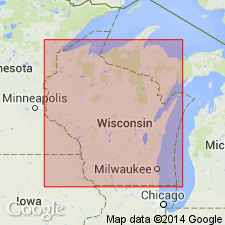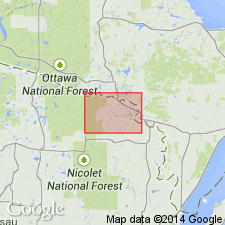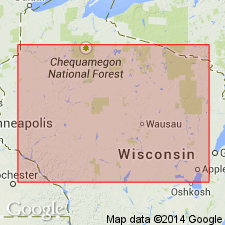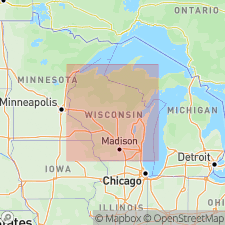
- Usage in publication:
-
- Copper Falls Formation
- Modifications:
-
- Original reference
- Dominant lithology:
-
- Sand
- Gravel
- Till
- AAPG geologic province:
-
- Wisconsin arch
Summary:
Pg. 4 (table 1); App., p. A11-1 to A11-7. Copper Falls Formation. Reddish-brown, mostly fluvial sand, gravel, and till. Thickness at type section 45 m. Occurs in broad area of northern Wisconsin and includes till derived from the Superior Lobe, Chippewa Sublobe, Wisconsin Valley Lobe (Ontonagon Lobe), and Langlade Lobe in the Lake Superior basin. In the Chippewa Sublobe area (Forest, Langlade, and Oneida Counties) includes Nashville Member (new). Unconformably overlies pre-Pleistocene or older Pleistocene units; unconformably underlies Miller Creek Formation (new) or lies at the surface. Age is Pleistocene (late Wisconsinan and possibly early Wisconsinan).
Type section: cutbank on west side of Bad River, 0.5 mi (0.8 km) northwest of Copper Falls, Copper Falls State Park, in SW/4 SE/4 NW/4 sec. 17, T. 45 N., R. 2 W., [approx. Lat. 46 deg. 22 min. 44 sec. N., Long. 90 deg. 38 min. 48 sec. W.], southeastern corner High Bridge 7.5-min quadrangle, Ashland Co., northern WI.
Named from Copper Falls State Park; name credited to Lee Clayton.
Reference section: [about 0.5 mi north of type section] in cutbank on west side of Bad River, 0.8 mi (1.3 km) northwest of Copper Falls, Copper Falls State Park, in SW/4 NE/4 SW/4 sec. 8, T. 45 N., R. 2 W., [approx. Lat. 46 deg. 23 min. 27 sec. N., Long. 90 deg. 38 min. 52 sec. W.], southeastern corner High Bridge 7.5-min quadrangle, Ashland Co., northern WI.
[Additional locality information from Syverson and others, 2011, Wisconsin lexicon of Pleistocene units, Wisconsin Geol. Nat. Hist. Survey Tech. Rpt., no. 1; supplemented from USGS historical topographic map collection TopoView, accessed on June 9, 2018.]
Source: Publication; US geologic names lexicon (USGS Bull. 1565, p. 74-75).

- Usage in publication:
-
- Copper Falls Formation
- Modifications:
-
- Areal extent
- AAPG geologic province:
-
- Wisconsin arch
Summary:
Pg. 6-11. Copper Falls Formation. In area of report, Florence County, Wisconsin, the Copper Falls and Horicon Formations become nearly indistinguishable. An arbitrary vertical cutoff is required somewhere in the broad zone of gradation between the two formations. The cutoff is here placed at the boundary between Florence and Marinette Counties. Horicon Formation is recognized in Marinette County, Copper Falls in Florence County.
Source: Publication.

- Usage in publication:
-
- Copper Falls Formation
- Modifications:
-
- Revised
- AAPG geologic province:
-
- Wisconsin arch
Summary:
Pg. vi (chart), 28-56. Copper Falls Formation. In the Superior, Chippewa, and Ontonagon Lobes of northwestern and central northern parts of Wisconsin, the Copper Falls Formation includes new formal members (alphabetical): Chetek (stream sediment), Crab Lake (till), Mikana (till and stream sediment), Pokegama (till), Poskin (till and stream sediment), Sylvan Lake (till, stream, and lake sediment), and Wildcat Lake (till). The Nashville Member (till) of Mickelson and others (1984) in Langlade Lobe, eastern northern Wisconsin, remains unchanged. Age of Copper Falls is considered Pleistocene (late Wisconsinan).
[On p. vi (chart), the Sylvan Lake, Chetek, and Poskin Members occur in Superior Lobe; the Mikana, Chetek, and Pokegama Members occur in Chippewa Lobe; the Crab Lake and Wildcat Lake Members occur in Ontonagon Lobe; and the Nashville Member occurs in the Langlade Lobe.
The youngest member, Crab Lake, was deposited around 12,000 yr B.P. Sylvan Lake and Mikana were deposited around 15,000 yr B.P. The Chetek, Wildcat Lake, and Nashville were deposited around 16,000 yr B.P. The oldest members, Poskin and Pokegama, were deposited around 19,000 yr B.P.]
Source: Publication.

- Usage in publication:
-
- Copper Falls Formation
- Modifications:
-
- Revised
- AAPG geologic province:
-
- Wisconsin arch
Summary:
[Not synopsized to date. Lithology, thickness, distinguishing characteristics, contacts, sections, areal extent, age, correlations discussed.]
Pg. 4 (fig. 2), 7 (fig. 3), 8, 58-87. Copper Falls Formation. Includes (ascending): Bakerville and Merrill Members (previously members of †Lincoln Formation), Pokegama Creek Member, Poskin Member, Mikana Member, Sylvan Lake Member, Wildcat Lake Member, Nashville Member, Crab Lake Member, and Sunrise Member. The Jardine Creek till (informal) might be equivalent to, or be a subdivision of, the Copper Falls.
Source: NA
For more information, please contact Nancy Stamm, Geologic Names Committee Secretary.
Asterisk (*) indicates published by U.S. Geological Survey authors.
"No current usage" (†) implies that a name has been abandoned or has fallen into disuse. Former usage and, if known, replacement name given in parentheses ( ).
Slash (/) indicates name conflicts with nomenclatural guidelines (CSN, 1933; ACSN, 1961, 1970; NACSN, 1983, 2005, 2021). May be explained within brackets ([ ]).

